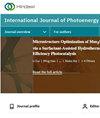带 PCM 的内/外径向鳍片散热器在功率 LED 的恒定和间歇功率模式下的效果实验研究
IF 2.1
4区 工程技术
Q3 CHEMISTRY, PHYSICAL
引用次数: 0
摘要
本文介绍了针对大功率 LED 优化基于 PCM 的散热器传热率的实验研究结果。该研究调查了五种类型的散热器,包括含 PCM 和不含 PCM 的散热器。对 LED 外壳和结点温度、LED 模块温度、热存储和释放率分析、三种循环工作模式分析、光通量和散热器热阻进行了独立研究。结果表明,基于 PCM 的 LED 散热器具有更好的散热性能。当功率为 10 W 时,装有 PCM 的 E-20 散热器的 LED 结温比没有装 PCM 的散热器低 9 摄氏度。此外,配备 PCM 的 E-20 散热器还延长了 LED 模块的关键寿命。另外,与不带 PCM 的 E-20 相比,带 PCM 的 E-20 在 10 W 时的热阻降低了 38.19%。根据这些结果,在不使用相变材料 (PCM) 的情况下,散热器 E-20 在 10 W 的功率下可发出 715 lm 的光。在输入功率相同的情况下,装有散热器和相变材料 (PCM) 的 E-20 的光通量为 750 lm,提高了 4.7%。最后,明确推荐带有 PCM 的 E-20 散热器适用于大功率 LED 热管理系统。本文章由计算机程序翻译,如有差异,请以英文原文为准。
Experimental Study on the Effect of In/Out Radial-Finned Heat Sink with PCM under Constant and Intermittent Power Mode in Power LEDs
The findings of the experimental study into optimizing the heat transfer rate of a PCM-based heat sink for high-power LEDs are presented in this work. The study investigated five heat sink types, with and without PCM. The LED case and junction temperatures, LED module temperatures, heat storage and release rate analyses, analyses of three types of cyclic operation modes, luminous flux, and heat sink thermal resistance were all examined independently. The results indicated that the PCM-based LED heat sink had improved thermal performance. The LED junction temperature of the PCM-equipped E-20 heat sink is nine degrees Celsius lower at 10 W than that of the heat sink without PCM. Furthermore, the E-20 heat sink with PCM extends the LED module’s critical lifespan. As a bonus, the E-20 with PCM had a 38.19 percent lower thermal resistance at 10 W than the E-20 without PCM. According to these results, the heat sink E-20 emits 715 lm at 10 W when operated without a phase-change material (PCM). With the same input power, the luminous flux of an E-20 equipped with a heat sink and a phase-change material (PCM) is 750 lm, a gain of 4.7%. Finally, clearly recommend the heat E-20 sink with PCM suitable for high-power LED thermal management system.
求助全文
通过发布文献求助,成功后即可免费获取论文全文。
去求助
来源期刊
CiteScore
6.00
自引率
3.10%
发文量
128
审稿时长
3.6 months
期刊介绍:
International Journal of Photoenergy is a peer-reviewed, open access journal that publishes original research articles as well as review articles in all areas of photoenergy. The journal consolidates research activities in photochemistry and solar energy utilization into a single and unique forum for discussing and sharing knowledge.
The journal covers the following topics and applications:
- Photocatalysis
- Photostability and Toxicity of Drugs and UV-Photoprotection
- Solar Energy
- Artificial Light Harvesting Systems
- Photomedicine
- Photo Nanosystems
- Nano Tools for Solar Energy and Photochemistry
- Solar Chemistry
- Photochromism
- Organic Light-Emitting Diodes
- PV Systems
- Nano Structured Solar Cells

 求助内容:
求助内容: 应助结果提醒方式:
应助结果提醒方式:


